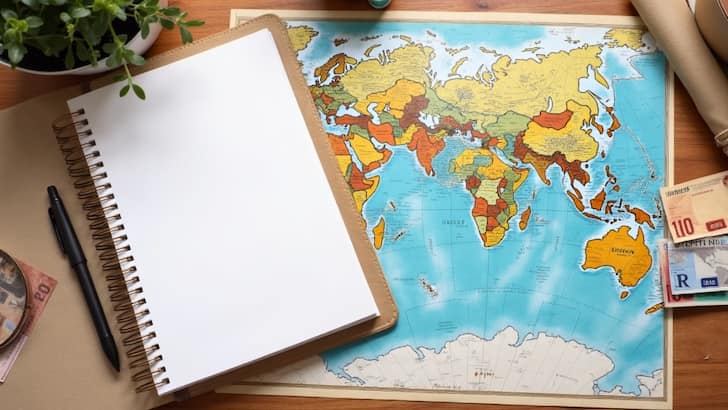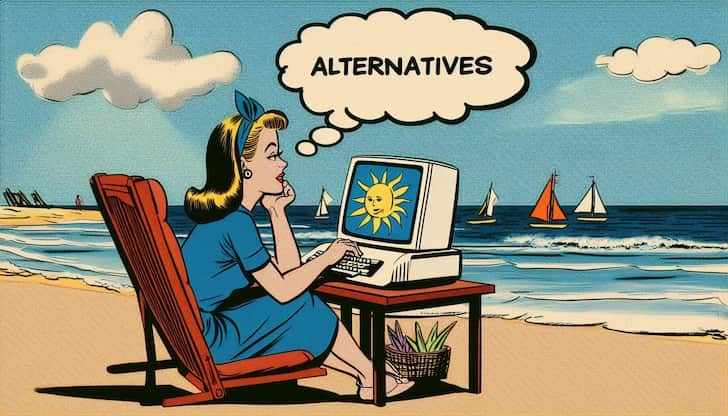If you have ever tried to find a practical, down-to-earth guide to managing finances for digital nomads and long-term travelers, you have probably seen plenty of vague advice or generic money tips. Recently, I picked up "Smart Money for the Wandering Life," a training course and eBook often shared in the travel blogging and slow travel community. The book promises to help people take control of their finances while living a flexible, location independent life. I spent the last week reading it, taking notes, and comparing its chapters with my own experience.
Below, I want to share my full take on the course, what I found useful, and areas that left me with more questions than answers. I’ll get into the details around pricing, who really created it, and whether it’s a worthwhile pick for today’s modern traveler.

Course Name: Smart Money for the Wandering Life
Website URL:
nomadfinanceguide.com
Price: $39.99 for the digital course
Author(s): Unlisted / Anonymous
Format: Digital book and step by step worksheets
Best For: Digital nomads, long term travelers, lifestyle experimenters
Community: None officially linked
Overall Rating: 3/5
Practical Tips: 3/5
Fresh Insights: 2/5
Support: 1/5 (no forum or email help)
Free Sample: YES. A single sample chapter is available on the website for email subscribers. No refunds after purchase.
I think it’s fair to say this guide will be helpful for someone brand new to the idea of digital nomad life or taking the leap into long term travel. The information is organized and offers simple, sequential steps that can give peace of mind to people who feel lost about their money plans. If you’ve already been on the road for a while, parts of the course are probably going to feel like old news. Still, the completed worksheets can be a good reality check for your financial health.
Who Wrote Smart Money for the Wandering Life?
Right away, the biggest question I had was about the author. The course doesn’t list a clear author, and the website is registered anonymously. There are references in the text to travel in Southeast Asia, Europe, and South America, but nothing clearly pointing back to a single person or team. There are no deep personal stories, only blend in travel anecdotes that feel generic.
From what I can see, most of the actual advice lines up closely with popular nomad blogs published over the last five years. A few case examples seem copy pasted, only changing the country or number amounts. I couldn’t find any community or social media presence for the author, so direct questions or follow-up is not an option.
This anonymity might make some people pause, especially if you like to ask questions or learn from someone’s real travel experiences. Since I have read a lot of digital nomad financial advice over the years, the lack of personal connection stands out. There’s no way to interact with the creator or see updated content if a law changes that affects banking or taxes for nomads.

What You Get When You Buy the Course
The download includes a PDF eBook (about 75 pages) and a set of fillable spreadsheets for budgeting, expense tracking, and travel planning. There’s a read through checklist for major tasks like opening international bank accounts, setting up cloud storage for documents, and running a remote business.
Here’s a breakdown of the main chapters you’ll find inside:
- Setting a Mobile Budget
- Banking and Cards for Travel
- Dealing with Currencies and Exchange Fees
- Emergency Funds for Nomads
- Finding Health and Travel Insurance
- Tracking Your Spending
- Making Money Remotely (Freelance, Remote Jobs, Passive Income)
- Taxes and Residency Basics
- Data Security and Passwords
- Digital Asset Organization (Cloud Backups for Documents)
- Packing Your Financial Documents
- Dealing with Locals, ATMs, and Cashless Societies
The fillable templates are neat if you’ve never used a money tracking app before. Each major chapter ends with a worksheet that pushes you to write down your choices and savings plans. This interactive element makes it easy to organize your next steps and keep everything straight as you prepare for travel.
How Actionable Is the Advice?
Most of the steps in "Smart Money for the Wandering Life" strike me as sensible, with clear directions anyone could follow. For example, the banking chapter lists well known digital banks and includes a side by side comparison of ATM withdrawal limits, costs, and mobile features. Budgeting guidelines rely on the classic “50/30/20” method: 50 percent for needs, 30 percent for wants, and 20 percent for savings or debt. There’s a suggested monthly spending range for common nomad hubs.
The course points out why keeping separate checking accounts (home/local) and travel accounts can be a good idea. There’s a dedicated sheet for emergency fund calculation, asking you to price out flights out of each country you might visit. These are practical steps I’ve used myself, and I don’t disagree with the basics.
However, a lot of the information feels like a repeat of standard budgeting or travel prep guides. Sections on insurance, password security, and backup storage are shared almost word for word from other beginner finance training I have come across. If you have searched for "how to set up international banking" or "budget for world travel," you’ve probably already seen similar lists of bank accounts, budgeting apps, and emergency money tips.
Does It Go Deep Enough for Experienced Nomads?
For anyone just getting started, the checklists can help with the overwhelm that comes from planning the money side of a long trip. I remember how chaotic it felt to arrange all my cards, get backups, and understand the math behind exchange rates before my own first big trip. These worksheets can help someone go from "I don’t know where to begin" to "I have a plan I can execute."
For people who already spend a lot of time on the road, I found the content to be too light. There are no interviews with actual travelers, no info about more advanced international tax optimization, or special visa issues for nomads.
Some chapters such as "Digital Asset Organization" feel more like a reminder than a true resource. It quickly reminds you to keep scans of your passport, medical documents, and credit cards, and suggests a cloud provider. Nothing is said about privacy threats with different cloud choices, or what to do during a data breach abroad.
Is the Course Content Up to Date?
The general advice in the course is pretty timeless. Things like maintaining an emergency fund, monitoring expenses, and splitting up accounts always make sense, no matter your travel destination. Still, banking and financial services for nomads change quickly. Providers merge, close accounts, or alter their fees. The examples used in the book include services that are still active, but the book doesn’t appear to be updated regularly.
There is no place to see changes in real time, and as I read, I noticed some outdated app interfaces and a retiree only card listed in the UK section that was discontinued in 2021. I always double check financial advice before acting, but some travelers might not know to do this.
Many of the listed insurance companies and banks are legitimate, but details such as limits, new customer location rules, or international transfer fees get updated more often than most print or static digital resources can keep up with. This is especially important for nomads or anyone planning to spend more than a month away from home, as financial rules outside your country may change often and quickly.

Key Areas That Helped Me
The biggest value the course provided for me was the strong checking and packing worksheets. I’m someone who tends to overthink, especially before a new country or long travel day. Having a clear emergency checklist that prompts you to write down your evacuation route and embassy contacts is a good stress buster. The worksheet reminded me to run another backup of my key documents and update my emergency notes for a new set of borders.
The course is at its best when it focuses on reminders for real world tasks, not theory. The “Dealing with Local ATMs and Cashless Societies” list includes a simple breakdown on how to spot ATM skimmers and why to avoid dynamic currency conversion. Packing the financial paperwork section also reminded me to update my physical and digital records and to keep a set of passport photos and hard cash in a backup wallet.
Main Areas That Missed the Mark
The biggest weakness is the lack of advanced tips or new insights for long time travelers. If you already know about the main digital banks and budgeting methods, there is not much new to learn. Some sections feel like filler, such as the part on passive income ideas, which just repeats very broad fields like "sell stock photos," "start a blog," or "teach English online" without sharing practical resources or real step by step guidance.
The course also skips over detailed topics such as setting up longer term tax residency in new countries, or what to do if you lose access to your home issued banking. Information about digital nomad visas or challenges for families and couples is missing. The resource list doesn’t contain real deep dives or links to outside web forums, so it feels isolated rather than part of the broader travel finance space.
Finally, it’s important to note the total lack of author transparency. The course does not include a way to interact, ask questions, or receive any kind of update when something major changes in the financial world. This is a sharp contrast to some paid courses from well known travel finance figures, who may offer private Slack groups, webinars, or at least a way to email the author.
Pricing, Refunds, and Who Will Benefit Most
At $39.99 for a static PDF and worksheets, the course falls squarely in the category of “intro guide.” There is a taste of value if you have never taken the time to plan your money before a big trip, but experienced digital nomads will likely not find enough new insight to justify the price. There is no refund policy, so once you buy, that’s it. I always prefer sample content or the chance to see user reviews before buying, and while the sample chapter gives a sense of the writing style, it really only covers budgeting basics.
If you are completely new to long term travel and you want a simple set of tasks to check off before booking your first trip, you may find comfort in having everything in one place. Just know that at least half of the content can be found, with some careful searching, from free travel and nomad budgeting guides online.
Practical Takeaways and Alternatives

In my opinion, the course is most useful as a "pre-travel" checklist builder or for people who enjoy straightforward worksheets without too much theory. Anyone trying to run a location independent business, optimize international taxes, or manage multiple residencies will need much more specialized and up to date guidance.
Some open alternatives that deliver fresh information and connect you with other travelers include:
- Nomad List, a huge community for remote work, costs, and city specific advice
- The Local Nomad, regular blog updates and practical tools for remote wallets
- Reddit r/digitalnomad, peer Q and A about banking, taxes, insurance, and real world gotchas
- Nomad Gate, detailed guides, up to date product reviews, and banking tips
If you like doing your own research, mix the basic templates from "Smart Money for the Wandering Life" with the ongoing updates from community driven sites to stay ready and flexible. Even seasoned travelers forget things, and a good worksheet or reminder can be worth the price if it keeps you from missing a detail or losing money before you head out.
There are some handy ideas in the course, but if you’ve been traveling for more than a few months or read a couple nomad books, much of the content will be common sense. That doesn’t make it useless, but it means it’s best for people just starting out or feeling overwhelmed by all the things that could go wrong with travel finances.
If you do pick it up, remember to double check any advice about banks or insurance by searching for the latest info online. Laws, product features, and even rules for nomads can change rapidly. Careful research helps travelers keep their money safe and stress low at every stop on your adventure.
If you want to talk about your plans for becoming a digital nomad, ask me in the comments or find me in one of the travel communities above. Good luck out there, and keep those emergency funds topped up!
How I "Finally" Make Over $7,000 Monthly Income
"The most valuable thing I've ever done!"

